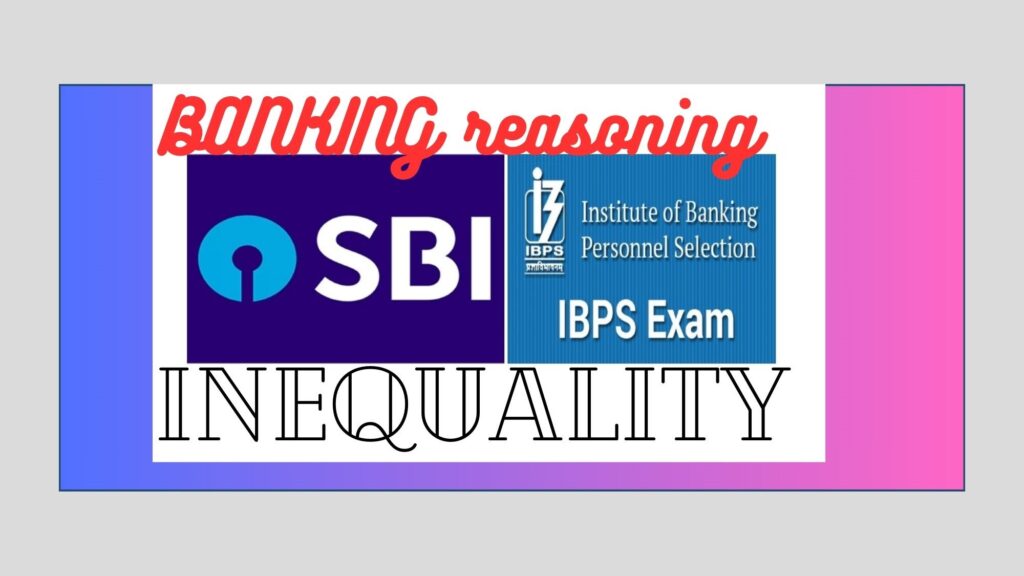
Inequality analytical reasoning for Bank Exams
প্রিয় পাঠক, ব্যাঙ্কিং পরীক্ষার উপযোগী রিজনিং ইনইকুয়ালিটি প্রশ্ন (Inequality analytical reasoning for Bank Exams )এখানে দেওয়া হলো।
ব্যাঙ্কিং রিজনিং-ইনইকুয়ালিটি-সেট -২
Directions (1-10) In each of these questions, relationship between different elements is shown in the statement(s). These statements are followed by two conclusions. Read the statement(s)and give Answer.
A) If only conclusion I is true
B) If only conclusion II is true
C) If either conclusion I or II is true
D) If neither conclusion I nor II is true
E) If both conclusion I and II are true
1)
Statement H ≥ I > J = K ≥ L = M
Conclusions I) J > M II) H > L
2)
Statement P > Q ≥ S, L ≤ N > S
Conclusions I) Q > N II) P > L
3)
Statement V < C ≤ D = E, R > P=E
Conclusions I) P ≥ C II) R > V
4)
Statement W = Y ≥ V = U < S ≤ T
Conclusions I) T ≥ V II) W ≥ U
5)
Statement S ≥ M > P, y < E = R ≤ P
Conclusions I) S > E II) Y ≥M
6)
Statement A > B ≥ C < D, C = E > G
Conclusions I) D > E II) B > G
7)
Statement P ≤ Q > M ≥ N, Q = S
Conclusions I) S > P II) N < S
Read More: Math Data Sufficiency-Set-2-You do not miss out IIডাটা সাফিসিয়েন্সি
8)
Statement S > M = Z > T < Q > V
Conclusions I) V= S II) Q > M
9)
Statement T < U = V ≤ S > P ≥ Q
Conclusions I) S > T II) V ≥ Q
10)
Statement M ≥ N > R > W, E= J > L ≥ W
Conclusions I) E > W II) M > L
>>>>>>>>>>>>>>>>>>>>>>>>>>>>>>>>>>>>>>>>>>>>>>>>>>>>>>>>>>>>>>>>>
Inequality analytical reasoning for Bank Exams-Answers
1.B) Given statement H ≥ I > J =K ≥ L= M
Thus H > L is true. Hence conclusion II follows.
Again J ≥M is true. So, conclusion I (J ≥M) is not true.
This conclusion I does not follow.
2.D) combining both the statements,
we get P ≥Q ≥S < N ≥ L
We can’t compare Q & N or P and L.
Therefore, neither conclusion I nor II is true
3. E) Combining both the statements,
we get V < C ≤ D = E = P < R
Thus C ≤ P or P ≥ C is true.
Hence conclusion I is true.
Again, V < R or R > V is true.
Hence conclusion II
also is true
4. B) combining both the statements,
we get W = Y ≥ V = U < S ≤ T
Thus V < T or T > V is true.
Hence conclusion I (T ≥ V) is not true
Again W ≥ U is true. Hence conclusion II is true
5. A) combining both the statements,
we get S ≥ M > P ≥ R = E > Y
Thus S > E is true.
hence conclusion II is true.
Read More: –Important Ranking Reasoning Questions-You do not miss out
6.E) combining both the statements,
we get A > B ≥ C = E > G & A > B ≥ C = E < D
Thus B > G is true.
Hence II is true
Again, D > E is true.
Hence, I is also true
7.B) combining both the statements,
we get P ≤ Q = S > M ≥ N
Thus P ≤ S OR S ≥ P IS True. Hence conclusion I (S > P) is not definitely true
Again S > n or N < S is true.
Hence II is true
8.D) combining both the statements,
we get S > M = Z > T < Q > V
Thus, we can’t compare V & S.
Hence conclusion I is not true.
And also, we can’t compare Q & M.
Hence II is not true
9.A) combining both the statements,
we get T < U = V ≤ S > P ≥ Q
Thus T < s or S > T is true.
Hence, I is true. But we can’t compare V & Q.
Hence conclusion II is not true
10.A) combining both the statements,
we get M ≥N > R > W ≤L < J = E
Thus, W < E or E > w is true. Hence conclusion I is true. we can’t compare M & L.
Hence II is not true.
>>>>>>>>>>>>>>>>>>>>>>>>>>>>>>>>>>>>>>>>>>>>>>>>>>>>>>>>>>>>>





